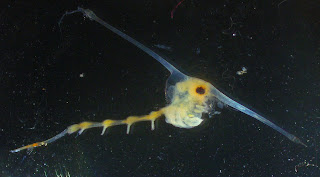Name that zoea!
Friends, it has been a productive few weeks over in my corner of the world. I'm busy at the microscope, sorting and identifying zooplankton from the Gulf of Mexico.
 |
| This zoea larva came from one of my plankton samples. Check out that spike! Long spines and spikes help protect plankton from predators. |
Last summer, I was part of a team investigating shipwrecks and natural hard-bottom reefs in the mesophotic zone, between 50 and 200 m deep. Recently, I've waded my way through all the ROV video we collected and found magnificent species of fish and corals along the way. The next step is to analyze plankton samples I collected when we were at sea.
I wasn't quite sure what would be in the plankton samples or what they would show. I've been curious for a while about how animals disperse to shipwrecks as larvae, so I thought that plankton samples collected from the water column right above shipwrecks might offer some clues.
Take a guess: Am I finding larvae of the corals and worms that inhabit the shipwrecks on the seafloor below? Am I finding something completely different? Or am I finding nothing at all?
_edit.jpg) |
| This megalopa larva is just about ready to settle on the seafloor and become a juvenile crab. |
Don't ask me why the species living on the shipwrecks and dispersing in the water above them are so different, because I have no clue yet. This is the exciting part of research: finding an unexpected pattern and learning something new about the world. I'm very excited to see what the plankton samples reveal!
Comments
Post a Comment